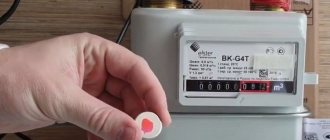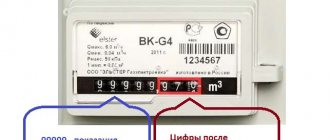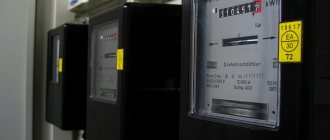The constant rise in prices for energy resources is a fact that cannot please the owners of houses and apartments, since as a result, the costs for all utilities become more and more from year to year. To be able to avoid unjustified overpayments, many owners install water, heat and gas meters. The latest equipment is now being installed more and more often. The reason for its growing popularity is the logical reluctance to pay at highly inflated standards. However, before choosing a model and purchasing a device, you need to find out what a gas meter is, what types of devices there are, and also understand their operating principle. This approach will allow you to find the optimal solution that you won’t have to regret in the future.
Where is the gas meter installed?
The location of the devices depends entirely on the building. For example, in apartments, gas meters are installed in kitchens - on a branch that comes from a common riser, and is intended for connection to any consumer: to a stove, a water heater, a boiler. According to the standards, the device is allowed to be mounted in kitchen cabinets, but in this case, the owners must ensure free access to the device, as well as its secure fixation on the wall.
In private homes, it is possible to place the gas meter on the external walls - in a special cabinet or under a canopy. However, with such an installation, several conditions must be met: there should be no power lines near the device, and vehicle passage in the immediate vicinity is also prohibited. For ease of access to the device at any time, one of the keys is transferred to the management company.
At whose expense are batteries replaced?
The following rules apply:
- If the battery fails during the manufacturer's warranty period, the battery in the gas meter is replaced at the expense of the selling organization. The technical passport for the product contains a list of parts that are covered by the warranty.
- If the warranty period has expired or the battery is not in the list of warranty parts, then the battery for the gas meter is purchased at the expense of the owner of the residential premises, who also pays for the installation of a new battery.
- It is possible to replace the gas meter battery free of charge in cases where such a procedure is specified in the service agreement concluded between the apartment owner and the sales company in St. Petersburg and the Leningrad region.
Before replacing the battery in the gas meter, you will need to submit a request. The installation team members bring the new battery with them. After the work is completed, the mechanism must be re-verified.
Types of gas meters
The principle of operation, as well as the design of the gas meter, depends on its purpose, power supply, measurement mechanism, as well as on throughput.
Main categories
There are two main types of gas metering devices. These are mechanical and electronic devices.
- Mechanical gas meters. In this case, the measuring mechanism is directly affected by the gas, moving at a speed depending on the pressure in the line. The fuel flow drives an element that transmits data to the counting device.
- Electronic meters. These models have an LCD display. Sensors that almost instantly send corresponding impulses are responsible for accurately determining the volume of incoming gas. Their quantity is immediately recorded, then recalculated and converted into flow meter indicators.
It cannot be said that one of the types has serious advantages over its competitor. The list of advantages of mechanical models includes a simple operating principle, easy maintenance, and complete independence from the functioning of the electrical network. The advantages of electronic gas meters are maximum accuracy and longer service life. However, their main disadvantage is their higher price.
Difference between designs
If we consider this equipment by type of design, it can be divided into 5 large groups.
Drums
These types of gas meters are used where maximum, standard accuracy of the devices is important. For example, in institutes, factory laboratories. The main element of the device mechanism is a measuring drum, divided into 4 equal sections. It is connected to the counter.
The container contains a barrier liquid (oil, water). Under the influence of gas pressure, the blades inside the drum rotate, and the 4 chambers are alternately filled or emptied. When turned, the section is released, allowing access to the gas device. In this case, neither the degree of gas purification nor temperature affects the measurements.
Vortex
These devices are also not the simplest designs, so they are practically not used in domestic conditions. In this case, pressure fluctuations are assessed. They are provoked by the creation of vortices inside the chamber. To do this, a “blimp body”—a truncated prism—is placed inside the device. Thanks to this obstacle, a vortex motion begins when gas is supplied.
All vibrations in the medium are read by two sensors, which guarantee the accuracy of the data due to their insensitivity to any interference - acoustic or vibration. Due to the correctness of measurements, vortex gas meters are used in industrial enterprises and for the needs of housing and communal services.
Membrane (diaphragm)
Such devices are most often found in everyday life. Their advantages are ease of operation and maintenance, accuracy when measuring small volumes of gas. The design consists of several (two, four) chambers connected together by a system of valves and channels. Gas entering the first chamber fills the space, after which the second one opens. When it is filled, a membrane connected to a mechanical counter pushes a portion of gas to the stove burner.
Since the volume of the chambers is known, gas calculation is simple. The valves are controlled using a crank-lever mechanism. Advantages of membrane devices: long service life, long verification interval (10 years), low price. Disadvantages: noise (“whistle”), large dimensions. Therefore, these gas appliances are not ideal for apartments of any size, since they cannot be hidden everywhere.
Rotary
This is another type of small mechanical model that can be called universal. Such gas meters are successfully used in domestic conditions, in industrial enterprises, and in boiler rooms. They are quite reliable, trouble-free, and can easily withstand short-term loads. The main working elements of the structure are two rotor blades, which begin to rotate due to the pressure created by the gas.
The number of revolutions is recorded by a mechanical counter. The minimum distance between the moving elements and the body of the device guarantees the accuracy of the readings. The advantages of rotary devices are good throughput, durability, compactness, and almost silent operation. The downside is the short verification interval (only 5 years).
Turbine (tachometer)
In this case, the principle of operation of the gas meter is slightly different: what is happening here is not determining the number of revolutions, but estimating the rotation speed of the working element, the turbine. The value depends on the gas pressure; the number of revolutions is accurately recorded by the counting device. It can be either mechanical or electronic.
Turbine gas meters are simple, reliable, and have high throughput. However, the large dimensions allow the devices to be used only in industrial enterprises. Another relative disadvantage is the dependence of the accuracy of the readings on the continuity and stability of the gas flow. In pulsating mode, the error increases.
Gas meter: operating principle
There are many more models, but it makes no sense to describe the rest, since they are usually not used in everyday life. If we talk about the principles of operation, then any device uses the property of the flow of gaseous fuel.
Operation of simple mechanical structures
It is better to briefly consider each device.
- Membrane. In this case, two measuring chambers separated by valves are filled alternately. Each of them has its own fixed volume. The inlet and outlet valves admit and release fuel. All movements of the membrane with the help of a lever are converted into rotation of the drive of the counting mechanism. It shows the amount of fuel passed.
- Vortex. These flow meters use the frequency of pressure oscillations, which changes its characteristics after giving the gas stream a vortex-like shape. The complexity of such a metering mechanism is the reason why these devices are expensive, and therefore are used exclusively at large gas distribution enterprises.
- Rotary. These devices “exploit” gas pressure. A counting device drive is connected to one of the two rotating rotors. It converts the number of revolutions into gas volume.
- Turbine. These devices measure the rotation speed of the turbine, which is driven by the pressure of the gas flow.
Although the models are structurally quite different, the differences in their operation are not so strong due to the same type of fuel. If we talk about a mandatory element of any flow meter, the meter operates according to the following scheme:
- The mechanism (body in vortex devices), placed in the body of the device, under the influence of gas pressure, does some work - fills the chambers, provokes vibrations, or rotates.
- This work is then recorded by a counter: rotational energy is converted into indicators, the number of revolutions is recorded, or the volume of fuel in the chambers is measured.
The sensors transmit all measurement results to a mechanically driven display. Some models may be equipped with additional devices. The price of such flow meters will be higher, but it is justified by their maximum convenience.
Electronic gas meter: operating principle
Such devices are usually called “smart”, since some models of these devices are actually almost independent: they can become one of the elements of the “smart home” system. The difference between electronic products and “elementary” competitors is electronic measuring modules. Their work is fully automated. Often models are autonomous, as they are equipped with rechargeable batteries.
Advantages of electronic meters
Electronic gas meters (ultrasonic, inkjet) have several advantages. The first of them is compactness, which allows the use of metering devices in apartments. But their advantages do not end there.
- Measurement accuracy. Thanks to sensors that are able to take into account different characteristics of gas under certain conditions (pressure, temperature, etc.), a rapid, most correct transition of mechanical energy into electrical energy occurs.
- Great information content. Electronic gas meters are equipped with liquid crystal displays, which are convenient because they can display the most accurate information needed by users.
- Electronic modules have non-volatile memory. Therefore, “devices within devices” are capable of not only storing, but also analyzing indicators recorded over a long period of time: usually a year.
The accuracy of the settings due to the ability to evaluate all the properties of the gas used is another advantage of smart devices. Some electronic models are equipped with additional elements: for example, a shut-off valve that will shut off the gas supply if a leak is detected. There are gas meters with a smart card: they make it possible to quickly “pay” for fuel.
What are the disadvantages?
One of them is the high price. The second applies only to models with a built-in battery. The service life of this device is from 3 to 4 years, which means that after the battery fails, you will have to forget about the autonomy of the electronic flow meter.
There is no other way to change the battery: if you go to the factory that produces this model. Many owners go the other way - they do this work themselves. A relative disadvantage is the need for careful handling of electronics. However, it will not be difficult, and careful treatment of any device will be the key to the longevity of the equipment.
Gas meter: are there advantages or not?
Before making a final decision on the advisability of such an acquisition and its installation, you need to weigh the pros and cons. There are few arguments.
Plus - savings
All measuring instruments make it possible to estimate the real, and not the standard, several times overestimated, consumption. This means that the owners will have a chance to significantly reduce the amount spent on gas payments. It is believed that the savings are serious - about 30%.
Saving the planet's resources is another positive point, since with a “vigilant”, accurate meter, it is unlikely that the owners will leave the stove on when running “idle”. Such careful treatment has long been required by resources that are depleted every day.
Downside: expenses?
The cost of this fuel is low, so many owners do not consider such a purchase a reasonable decision. If we take into account the installation of a gas meter, the amount increases even more, so the additional device will not pay for itself immediately. You also need to consider future maintenance costs, as well as meter replacement.
To have a gas meter or not? In a private house where several appliances use gas at once, this solution is absolutely justified. As for apartments with gas stoves, everything depends on the owners themselves. But, most likely, in the near future the installation of metering devices will become “legally mandatory”, so sooner or later everyone will have to do this procedure.
How to choose a gas meter?
The main recommendation regarding the advisability of purchasing a particular device should come from representatives of the gas company servicing the house. The reasons are their awareness of the peculiarities of the state of the gas circuit, the quality of the fuel, and the maintainability of a particular area. If we talk about what owners of apartments or houses pay attention to, then in this case several factors are taken into account.
Bandwidth
This is the main question of interest to consumers, since the longer the service life of the device, the longer it can be used. The maximum gas volume can be found in the device data sheet. To calculate the throughput of a product, first sum up the consumption of gas appliances available in the home. All data is easy to find in the passport (slabs, columns, etc.). Then add at least 10% to the result obtained. For domestic needs, devices with a throughput capacity of 1.6-6 m3 are sufficient.
- For one consumer (stove), a gas meter is required with a maximum throughput of 2.5-4 m3/h (G-1.6, G-2 on the display).
- When the maximum gas flow is 4-6 m3/h, the optimal meter is designated G-2 or G-4.
- Large hourly consumption (6-16 m3) already requires more serious devices - from G-4 to G-10.
For small boiler houses, flow meters capable of flowing 10-40 m3/h are purchased. For industrial enterprises, they choose the most productive equipment - meters designed to work with large volumes of gas: for example, more than 40 m3.
terms of Use
For some devices, the presence of a temperature compensator (also called a thermal corrector) is extremely important. This element stabilizes the meter readings if the fuel temperature differs from the norm, which is 20°. Such gas flow meters are optimal for private homes if they are located on the street.
During the cold season, gas loses a lot in volume, so the supplier bears the losses. In the hot summer, the situation is the opposite: due to the significant expansion of fuel, on the contrary, the consumer remains at a loss. The presence of a temperature compensator is indicated by the letter “T” in the model name.
Design Features
A wide range of similar products allows you to choose left- or right-handed counters. The direction of supply of the mixture is the second factor that is taken into account. The matching diameters of the connecting pipe and pipe are another prerequisite.
For installation in apartments, the diameter of the threaded connection is ½ inch; for installation in a private home, the range is wider: ½ inch, ¾ or 1 inch are suitable. For industrial facilities, larger diameter pipes and flanges are used.
date of manufacture
It is better to always pay attention to these numbers. Such counter devices, unlike other products, have a special feature. Their service life does not begin after installation; it starts from the date of manufacture. This data can also be found in the product data sheet.
The calibration interval is another important factor. The longer the device lasts without technical inspection, the less its inspection, verification and maintenance will cost.
What documents need to be prepared?
The standard package of documents includes:
- Passport for the old meter.
- Civil passport of the property owner. A copy is acceptable.
- Meter installation project.
- Information about the last verification of the meter.
- Agreement on technical VDGO.
- House plan.
You will also need to write a statement containing the following information:
- Passport and contact details of the subscriber.
- The address where the meter needs to be replaced.
- Registration number and meter model type.
- Indicators of devices before replacement.
- Date of the first and last meter verification.
The application can be written at the territorial office of the service.
Deadlines
According to Government Decree No. 354, the period for replacing a gas consumption meter should not exceed 30 days. After the new meter is installed, within 3 days the management company must contact the subscriber and agree on a date for sealing the meter.
During the time until the new meter is suitable for use, charges for gas use will be charged according to the standard established by law.
Features of installation of gas flow meters
Work on gas equipment should only be carried out by authorized representatives of the service company. However, future owners of gas meters will not hurt to know a few rules.
- Fuel temperature. The permitted temperature range is quite wide: from -20 to +60°. However, limit values, or values close to them, are still not recommended. For this reason, a device located outdoors may require good thermal insulation.
- Outdoor flow meters are recommended to be installed at a distance of 1.6 m from the ground surface. There are no such restrictions for a house or apartment, since everything is decided only by where the branch from the common riser is located.
- The distance from the gas meter to any heating device should be 0.8-1 m, no less. Otherwise, the operation of the flow meter will be affected.
Good ventilation of the room is a must. Just like water meters, gas appliances must be sealed before use.
The owners decide which gas meter to buy, since much, if not all, depends on specific conditions. The following video may suggest an answer if the favorite has not yet been found by future owners:
The legislative framework
According to the legislation of the Russian Federation, Art. No. 4871-1 of 1993 “On ensuring the uniformity of measurements”, gas consumption measuring instruments should be delivered for verification in a timely manner. This is the responsibility of the equipment owner.
It is prohibited to change the gas meter yourself . The procedure must be carried out by specialists who have the right to carry out work on replacing gas equipment.
In safety requirements or labor protection instructions, gas-hazardous work must be entrusted only to workers with special training and confirmed qualifications. It is also prohibited by the gas service to replace the battery yourself.
If the nutrient element has run out, the technician removes the filling, loading the readings into the database before work. After removing the housing cover, the specialist carefully removes the electronic board with the battery and loads a new one in its place.











